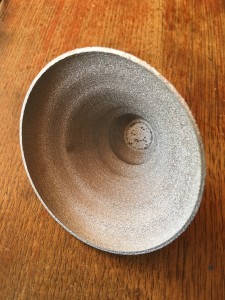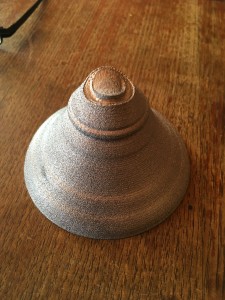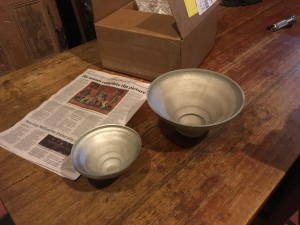Lab 22 CSIRO is focussed on 3D printing directly in metal and the focus of my specific research in the Synapse program has been to discover the tuning effects of a known cast bell sound when the bell design has been 3D printed directly in metal.
Types of direct metal printing include using metal powders (titanium, stainless-steel and bronze amongst the most usual materials) placed in electron beam or laser heat sources to fuse the metal particles layer by layer. Alternative methods include accelerating particles to speeds high enough that they fuse with metallic layers already printed and the use of robotic arms and temperature-controlled environments in which electric arc (mig) welding continuously builds layers of fused metal.
Dr Daniel East, Gary Savage and I wanted to see the results of printing process offered in the US by Exone Company using a system where stainless-steel powder is printed in layers with a resin to form a resin bound stainless-steel form which is placed in a kiln and has bronze powder added. At temperatures above 1011 Celsius the resin is burnt out and replaced with liquid bronze. We ordered one Longnow Clock bell design in the materials 316 stainless-steel and a tin bronze of Cu 90% Sn 10%, and another in the materials 420 stainless-steel and the tin bronze, with a 60 % stainless to 40% bronze ratio.
I include pictures of both bells and note that both bells hold the partial frequency array of cast bronze bells, with both bells generating a difference tone, that is a pitch with a psychoacoustic effect of sounding one octave below the lowest actual partial frequency, its fundamental, sounded in the bell. I believe these to be the first ever 3D direct metal printed bells, and so it seems right that their design be of the newly invented Longnow Difference-tone Bell. Danny Hillis of the Longnow Foundation gave his blessing to this research using the Longnow bell design.
More recently, Lab 22 has printed a 95mm mouth diameter difference tone bell design in titanium using the Electron Beam Printer and this bell also retains the same partial frequency array as a cast bronze bell at the same scale. There are plans to print a larger titanium bell at Lab 22, and some of the small Mathematician Instrument Sculptures I designed whilst in residency at La 22.
Although I have now completed my wonderful Synapse Residency at CSIRO I feel sure that a research relationship with them will endure. I cannot thank ANAT and CSIRO enough and of course everyone at Lab 22 Clayton for allowing me the amazing experience of working in that research environment. The residency has been inspirational for me and has enlarged my vision of what is possible in orders of magnitude I can but hope to demonstrate with my ongoing research into the history, tradition, sound and technology of bell (and sound) design in public-space.






